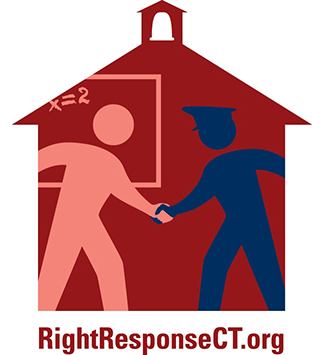|
right response CT
CT just start—unequal treatment of youth
school police collaboration
school police training
using youth behavior data
understanding disciplinary data
CT juvenile justice
CT funding opportunities
links |
 Schools and police share responsibility for school safety and must work together with complementary policies and procedures. Creating a collaborative model to guide school/police efforts in the state has the potential to positively impact the academic success of students and to limit the involvement of students in the juvenile justice, welfare and correction systems. Schools and police share responsibility for school safety and must work together with complementary policies and procedures. Creating a collaborative model to guide school/police efforts in the state has the potential to positively impact the academic success of students and to limit the involvement of students in the juvenile justice, welfare and correction systems.
The school police collaboration efforts of the Juvenile Justice Advisory Committee (JJAC) are based on the following five principles.
- The vast majority of student misconduct can be best addressed through classroom and in-school strategies and maintaining a positive climate within schools rather than by involvement of the justice system.
- The response to student misbehavior should be reasonable, consistent and fair with appropriate consideration of relevant factors such as the age of the student and the nature and severity of the incident.
- Students should be held accountable for their actions through a graduated response to misconduct that provides a continuum of services and increasingly more severe sanctions for continued misbehavior.
- Disruptive students should receive appropriate redirection and support from in-school and community resources prior to the consideration of suspension, expulsion, involvement of the police, or referral to court.
- Clarifying the responsibilities of school and police personnel with regard to non-emergency disruptive behavior at school and school-related events promotes the best interests of the student, the school system, law enforcement and the community at large.
The model Memorandum of Agreement (MOA) between the Superintendent of Schools and the Chief of Police is a formal document expressing the agreed upon policies for responding to non-emergency school disruptions, including a chart of types of behavior with appropriate interventions by level of intervention.
The Effective School Staff Interactions with Students and Police is a one day training for all personnel working in schools, particularly middle and high schools, with a major emphasis on school police collaboration.
The Right Response CT Network is a group of Connecticut communities working with the JJAC and others in the network to improve school disciplinary systems by sharing information, resources and best practices. Participating communities must convene a local collaboration team with school, police and community members that meets regularly, participates in Network training sessions, implements a model Memorandum of Agreement (MOA), and works towards system change. The JJAC offers Right Response CT Network grants to communities and training and technical assistance events. |